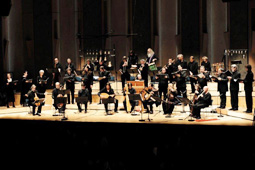
Ancient music’s most important value stems from its ability as a universal artistic language to transmit feelings, emotions and ancestral ideas that even today can enthral the contemporary listener. With a repertoire that encompasses the period between the 10th and 18th centuries, Hespèrion XXI searches continuously for new points of union between the East and West, with a clear desire for integration and for the recovery of international musical heritage, especially that of the Mediterranean basin and with links to the New World.
In 1974 Jordi Savall and Montserrat Figueras, together with Lorenzo Alpert and Hopkinson Smith, founded the ancient music ensemble Hespèrion XX in Basel as a way of recovering and disseminating the rich and fascinating musical repertoire prior to the 19th century on the basis of historical criteria and the use of original instruments. The name Hespèrion means “an inhabitant of Hesperia”, which in ancient Greek referred to the two most westerly peninsulas in Europe: the Iberian and the Italian. It was also the name given to the planet Venus as it appeared in the west. At the turn of the 21st century Hespèrion XX became known as Hespèrion XXI.
Today Hespèrion XXI is central to the understanding of the music of the period between the Middle Ages and the Baroque. Their labours to recover works, scores, instruments and unpublished documents have a double and incalculable value. On one hand, their rigorous research provides new information and understanding about the historical knowledge of the period, and on the other hand, the exquisite performances enable people to freely enjoy the aesthetic and spiritual delicacy of the works of this period.
Right from the beginning Hespèrion XXI set out on a clearly innovative and artistic course that would lead to the establishment of a school in the field of ancient music because they conceived, and continue to conceive, ancient music as an experimental musical tool and with it they seek the maximum beauty and expressiveness in their performances. Any musician in the field of ancient music will have a commitment to the original spirit of each work and has to learn to connect with it by studying the composer, the instruments of the period, the work itself and the circumstances surrounding it. But as a craftsman in the art of music, he is also obliged to make decisions about the piece being played: a musician’s capacity to connect the past with the present and to connect culture with its dissemination depend on his skill, creativity and capacity to transmit emotions.
Hespèrion XXI’s repertoire includes, amongst others, the music of the Sephardi Jews, Castilian romances, pieces from the Spanish Golden Age, and Europa de les Nacions. Some of their most celebrated concert programmes are Les Cantigues de Santa Maria d’Alfons X El Savi, La Diàspora Sefardí, the music of Jerusalem, Istanbul, Armenia and the Folías Criollas. Thanks to the outstanding work of numerous musicians and collaborators who have worked with the ensemble over all these years Hespèrion XXI still plays a key role in the recovery and reappraisal of the musical heritage, and one that has great resonance throughout the world. The group has published more than 60 CDs and performs concerts for the whole world, appearing regularly at the great international festivals of ancient music.
2025
HESPERION XXI - FR
La valeur la plus importante de la musique ancienne réside dans sa capacité, en tant que langage artistique universel, à transmettre des sensibilités, des émotions et des idées ancestrales qui, encore de nos jours, captivent le spectateur. Avec un répertoire allant du Xe au XVIIIe siècle, Hespèrion XXI recherche en permanence de nouveaux points de rencontre entre l’Orient et l’Occident, dans une volonté claire d’intégration et de récupération du patrimoine musical international, notamment dans la zone méditerranéenne et en connexion avec les musiques du Nouveau Monde américain.
En 1974, à Bâle, Jordi Savall et Montserrat Figueras fondent, aux côtés de Lorenzo Alpert et Hopkinson Smith, le groupe Hespèrion XX, un ensemble de musique ancienne qui souhaitait récupérer et diffuser le patrimoine musical riche et fascinant antérieur au XIXe siècle à partir de nouvelles prémisses : les critères historiques et les instruments originaux. Son nom, Hespèrion, signifie « originaire d’Hespérie » qui, en grec ancien, désignait les deux péninsules les plus occidentales d’Europe : l’ibérique et l’italienne. C’était aussi le nom que recevait la planète Vénus quand elle apparaissait à l’Occident. Dès l’an 2000, Hespèrion XX change son nom par celui d’Hespèrion XXI.
Hespèrion XXI est aujourd’hui une référence incontournable pour comprendre l’évolution de la musique dans la période allant du Moyen Âge au Baroque. Son travail de récupération d’œuvres, partitions, instruments et documents inédits possède une double valeur incalculable. D’une part, le travail de recherche rigoureux apporte des données et des interprétations sur les connaissances historiques d’une époque ; d’autre part, l’exécution exquise des interprétations permet au public de profiter de manière naturelle de la délicatesse esthétique et spirituelle propre des œuvres de cette époque-là.
Dès ses débuts, Hespèrion XXI a adopté une orientation artistique claire et innovante qui finirait par faire école au sein du paysage mondial de la musique ancienne car le groupe concevait, et conçoit encore, la musique ancienne comme un outil d’expérimentation musicale avec laquelle il recherche la plus grande beauté et la plus haute expressivité dans les interprétations. Tout interprète de musique ancienne prend un engagement par rapport à l’esprit original de chaque œuvre et doit apprendre à connecter avec celui-ci en étudiant son auteur, les instruments de l’époque, l’œuvre en soi et ses circonstances concrètes. Toutefois, en tant qu’artisan de la musique, il est également obligé de prendre des décisions sur ce qu’il interprète : de son talent, de sa créativité et de sa capacité à transmettre des émotions dépend sa capacité à connecter le passé avec le présent, la culture avec sa divulgation.
2025
Please destroy all previously dated material.
N.B. NO CHANGES ALLOWED without our permission.